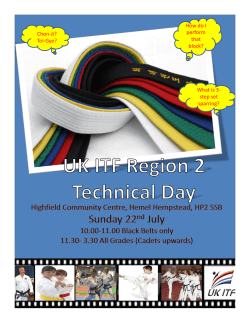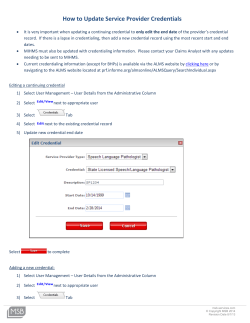
April 14, 2015 - International Society of Fire Service Instructors
2015 ISFSI Membership Social Premier Networking Event for ISFSI Members at FDIC 2015 Tuesday, April 21, 2015 6:00 - 9:00 p.m. Mo's A Place For Steaks Indianapolis, IN Sponsored By: Honeywell, Scott Safety and Columbia Southern University 2015 ISFSI Annual Meeting Friday, April 24, 2015 1:00 - 3:00 p.m. Sagamore Ballroom 7 Indianapolis Convention Center Sponsored by: BlueCard Command, VFIS and IFSTA Lunch will be provided. --Door prizes will be awarded at both the Membership Social and Annual Meeting. Current door prizes include: Alabama Fire College - Scholarship for a training certification/class not to exceed $500.00 Bshifter - BlueCard Certification Package with Fire Command book and t-shirt Father & Son Team Classic -Two person team entry to Family Golf Week; July 15-18, 2015 in Myrtle Beach, SC. Includes a three day golf tournament. Bust-A-Duck - Two person entry for the 4th Annual Firefighter Brotherhood Duck Hunt; January 2016. Includes two days of hunting for two people. Fire Engineering Books and Videos - Autographed Gift Package; contents TBD. Safe Industries - Cairnes 1010 Firefighting Helmet Honeywell - Custom Instructor Turnout Gear Jones & Bartlett - Book Set Visit us at Booth 5469 April 20-25, 2015 FDIC 2015 Rules of Engagement For Safe Fire Service Training 1. Have a clear purpose for the training exercise and use a training plan with defined outcomes and learning objectives. Review the plan with all participants before training begins. 2. Establish and maintain a clear chain of command during training. Designate a training incident commander/lead instructor. Don't let participants pull rank and compromise safety. 3. Never allow freelancing during training. Require the use of staging and accountability systems. 4. Use only qualified instructors who possess both certification and experience in the subject they are teaching. 5. Adhere to all national, state and local standards for conducting training. 6. Only conduct training under acceptable conditions. Don't place participants in a realistic environment before they are ready for it. Never use live victims during high-risk training. 7. Use all possible safety precautions during training, even if they exceed what is possible during an actual emergency event. Even though it's "just training", never overlook safety precautions. 8. Require all participants to be medically cleared before they participate in strenuous training. Enforce appropriate rehabilitation and monitoring during and after training. 9. Make sure the training is appropriate for the skill level of all participants and that they know what is expected of them. 10. Allow all participants to stop - without penalty - if they don't understand their assignment or if they sense something unsafe during training. Stop, talk and decide on a safer approach. Everyone is a safety officer. The Rules of Engagement© are a product of the IAFC Safety, Health and Survival Section in partnership with the North American Fire Training Directors Sponsored by Alabama Fire College and Fire Rescue In The Interest Of All Firefighters Returning To Quarters Safely ...After Every Run Principles of Modern Fire Attack: SLICE-RS Program View the full schedule of classes here. If you are interested in hosting the program, please contact Leigh Hubbard by email at leigh.hubbard@isfsi.org. Live Fire Training - Why It's Important to You The live fire environment for firefighters has changed significantly over the past decades with the increased use of plastics, light weight construction methods and other factors that are currently being studied by firefighters and scientists alike. Likewise, the training environment is changing for firefighters as well. While actual fires are decreasing, the demand for effective, efficient and safe firefighting operations continues to increase. We must meet these training challenges with fresh look at how we train our firefighters. While we would like to simulate the effects of lightweight construction and use of plastics and polycarbonates in training, we know from experience and on the backs of dead firefighters that this is implausible and inexcusable. We must fight the urge to place an unrealistic expectation of how much heat or real life fire conditions on our firefighters with the reality that as instructors, we are responsible for our trainee’s lives and that at the end of the day, Everybody Goes Home. The ISFSI has successfully developed a training program to credential fire instructors across the county to face those challenges of providing meaningful training while not exceeding or sacrificing basic safety principles of fire training. The ISFSI Live Fire Instructor Credential is a multifaceted training program geared at training fire instructors to provide training under established safety guidelines from best practices from organizations such as IAFC and IAFF and under direction from the NFPA Standards. While it is true that the majority of the program is focused on NFPA 1403, the credential goes deeper into just one standard alone. There are over 20 other standards referenced in the program including gear and uniforms to the LPG standard. The three day credential is a combination of pre-class online assignments, class room study, discussion and activities to practical evolutions to include the addition of a live fire environment. The instructor is grouped with other instructors from their area, their state or other places in the country to network training ideas and best practices. While I would love to say that the content is the best part of the class, I would be lying if I didn’t admit that it is working with other instructors and developing professional relationships that make us all better instructors. Hosts for the LFT class are eagerly accepted and encouraged. To host a class, see the ISFSI web site and contact Jamie Lacy, for more information. The live fire fixed facility credential is continually being improved and the next phase of the program, Acquired Structure credential and the Instructor in Charge credential is set to be launched this year. The credential comes with the added benefit of a one year’s membership to ISFSI where over 2,000 other instructors' network and increase the self-worth of the instructor. After all, we are not out to hurt our firefighters, we are supposed to make them better than when they began the training. This months ISFSI Contributing Author is Captain Steve Oughterson with Lebanon Fire Department in Ohio. He is a lead instructor for the ISFSI Live Fire Training Fixed Facility Instructor Credentialing Program. Contact Steve by email at soughterson@lebanonohio.gov. ISFSI Newsletter Feedback Survey - Please take a few minutes to complete this quick survey. Your feedback is encouraged so we can provide the content you want to see.
© Copyright 2025










